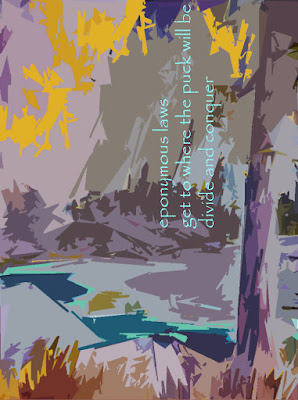 |
| (click on image to enlarge) |
In
my first post on Elegant Clean Energy Haiku, I mentioned a plan to
program a computer to write and illustrate haiku in a manner I hoped would be
reminiscent of Norman McLaren of the National Film board of Canada…
Getting
a computer to write haiku (well, a haiku-like non sequitur) is fairly straightforward. (Should you be wondering, Wikipedia defines ‘non sequitur’ as a logical fallacy where a stated conclusion
is not supported by its premise and therefore the conclusion is arbitrary.)
Persuading my computer to produce an abstract illustration of the lines of haiku as it prints them, however, is a part of the project I haven't even started. When I figure that out, I’ll post an outline of the methodology. Meanwhile, here is a haiku example, overlaid on a computer-abstracted version of the painting of the Opabin Plateau I wrote about last week. I’ll explain the objective of these verses in my next ‘haiku’ post.
Persuading my computer to produce an abstract illustration of the lines of haiku as it prints them, however, is a part of the project I haven't even started. When I figure that out, I’ll post an outline of the methodology. Meanwhile, here is a haiku example, overlaid on a computer-abstracted version of the painting of the Opabin Plateau I wrote about last week. I’ll explain the objective of these verses in my next ‘haiku’ post.
A
‘how to invent stuff’ non sequitur
Watercolour
and Photoshop™
©2015 Charlene Brown
According to Leon Zolbrod, in his book, Haiku Painting, haiku illustration,
or haiga,
transcends the world of haiku poetry, revealing new insights that the poem
alone, despite the inimitable expressiveness of Japanese calligraphy, cannot
express. From the beginning of haiku development in the 17th
century, poet and haiga artist alike endeavored to eliminate every superfluous
element and to attain an austere beauty, akin to that of abstract art,
associated with the discipline of Zen and its emphasis on purity and
simplicity.






